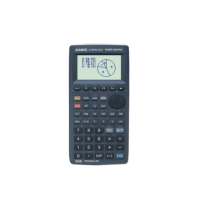
Do you have a question about the Casio fx-7400G PLUS and is the answer not in the manual?
| Model | fx-7400G PLUS |
|---|---|
| Category | Graphing Calculator |
| Display | LCD |
| Display Lines | 8 |
| Display Characters | 21 |
| Memory | 28 KB |
| Power Supply | Battery |
| Programming | Yes |
| Graphing | Yes |
| Equation Solver | Yes |
| Statistical Functions | Yes |
| Connectivity | No |
| Battery | AAA x 4 |
Explains the calculator's main menu and its icons for selecting operational modes.
Details the layout and functions of the calculator's keys, including alpha lock functionality.
Describes color coding for key functions and how to access them for enhanced usability.
Guides users on how to enter different operational modes and configure settings via the setup screen.
Explains the two types of display (text/graphic) and menu item conventions used.
Provides instructions on how to adjust the display contrast for optimal readability.
Offers troubleshooting steps for common operational issues and low battery warnings.
Covers basic arithmetic operations of addition and subtraction with practical examples.
Explains how to perform multiplication on the calculator with examples.
Details the process of performing division, including the effective use of parentheses.
Explains how to obtain the quotient and remainder from integer division operations.
Covers calculation priority, parentheses, negative values, and exponential expressions.
Explains Answer Memory, consecutive calculations, replay, error recovery, and corrections.
Describes how to assign and use variables (A-Z) for storing numeric values.
Guides on fraction display, input, calculations, and conversions between fractions and decimals.
Explains how to set display modes for Fix, Sci, and Norm (exponential range) settings.
Covers trigonometric, logarithmic, exponential, coordinate conversion, and permutation/combination functions.
Introduces graphing capabilities and the GRAPH mode for function visualization.
Details how to set the display range, scale, and parameters for graphing.
Explains storing, editing, and deleting graph functions in memory for plotting.
Guides on manually drawing graphs using sketch commands for custom visualizations.
Covers trace, scrolling, zoom, and sketch functions for graph analysis and manipulation.
Instructions for storing mathematical functions in memory for table generation.
Explains how to remove stored functions from memory to manage stored data.
Details methods for assigning values to variables, including range and list assignment.
Guides on selecting functions and generating numeric tables based on variable ranges.
Covers adding or deleting lines within an existing numeric table for data refinement.
Explains how to graph functions directly from a generated numeric table.
Describes how to copy table data columns into lists for further analysis.
Covers inputting data into lists, one-by-one or in batches, for data management.
Details editing cell values, deleting cells, deleting lists, and inserting new cells.
Explains functions for list manipulation like counting, filling, generating sequences, and finding stats.
Covers performing arithmetic operations using lists and inputting lists into calculations.
Introduces the STAT mode and basic data input for statistical analysis.
Provides examples of inputting data and performing initial statistical calculations.
Explains histograms, box graphs, normal distribution curves, and displaying results.
Covers linear, Med-Med, quadratic, logarithmic, exponential, and power regression graphs.
Guides on manual graphing, including setting histogram width and performing calculations independently.
Details how to specify data lists and perform calculations directly without graphing.
Introduces the programming function for complex calculations and program storage.
Provides examples for creating and registering programs, including file names and input.
Explains how to identify and fix bugs in programs, including error messages.
Details memory usage for commands and checking available memory capacity.
Describes how to protect programs with passwords for limited access.
Explains methods for finding programs using scroll, file name, or initial character search.
Guides on recalling and editing program code, similar to manual calculation editing.
Covers procedures for deleting specific programs or all programs from memory.
Lists and explains command categories (COM, CTL, JUMP, CLR, DISP, REL, I/O) for program creation.
An index and description of all available calculator commands used in programming.
How to include text labels and prompts within programs for clarity and user guidance.
Incorporating graph, table, and statistical functions into programs for advanced automation.
Instructions for connecting two calculators using an SB-62 cable for program transfer.
Details connecting the calculator to a PC via a CASIO Interface Unit for data transfer.
Explains connecting to a CASIO Label Printer using an SB-62 cable for printing screen data.
Introduces the LINK mode and data communication setup, including fixed parameters.
Guides through the process of sending and receiving data between units or with a PC/printer.
Describes how to send a bit-mapped screen shot of the display to a connected computer or printer.
Lists precautions to avoid errors and ensure successful data transfer operations.
Details a program for finding prime factors of positive integers up to 10^10.
Explains a program using Euclidean division to find the greatest common measure of two integers.
Describes a program for calculating t-test values using sample mean and standard deviation.
A program to find slope and intercept of tangent lines to a circle from an external point.
A program for graphing the rotation of geometric figures by a specified angle using coordinate transformation.
Provides precautions for correctly replacing main and backup batteries to prevent damage and data loss.
Explains the automatic power-off feature for energy saving and how to restore power.